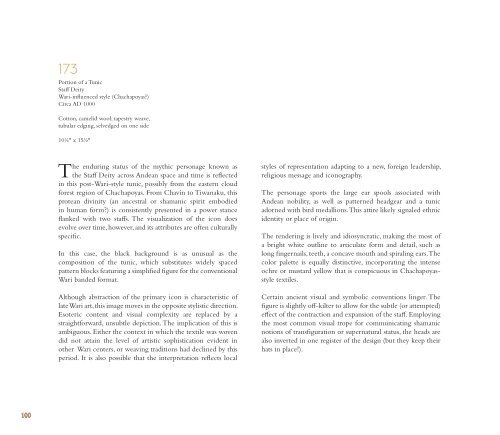You also want an ePaper? Increase the reach of your titles
YUMPU automatically turns print PDFs into web optimized ePapers that Google loves.
173<br />
Portion of a Tunic<br />
Staff Deity<br />
Wari-influenced style (Chachapoyas?)<br />
Circa AD 1000<br />
Cotton, camelid wool; tapestry weave,<br />
tubular edging, selvedged on one side<br />
10½" x 15½"<br />
The enduring status of <strong>the</strong> mythic personage known as<br />
<strong>the</strong> Staff Deity across Andean space and time is reflected<br />
in this post-Wari-style tunic, possibly from <strong>the</strong> eastern cloud<br />
forest region of Chachapoyas. <strong>From</strong> Chavín to Tiwanaku, this<br />
protean divinity (an ancestral or shamanic spirit embodied<br />
in human form?) is consistently presented in a power stance<br />
flanked with two staffs. The visualization of <strong>the</strong> icon does<br />
evolve over time, however, and its attributes are often culturally<br />
specific.<br />
In this case, <strong>the</strong> black background is as unusual as <strong>the</strong><br />
composition of <strong>the</strong> tunic, which substitutes widely spaced<br />
pattern blocks featuring a simplified figure for <strong>the</strong> conventional<br />
Wari banded format.<br />
Although abstraction of <strong>the</strong> primary icon is characteristic of<br />
late Wari art, this image moves in <strong>the</strong> opposite stylistic direction.<br />
Esoteric content and visual complexity are replaced by a<br />
straightforward, unsubtle depiction. The implication of this is<br />
ambiguous. Ei<strong>the</strong>r <strong>the</strong> context in which <strong>the</strong> textile was woven<br />
did not attain <strong>the</strong> level of artistic sophistication evident in<br />
o<strong>the</strong>r Wari centers, or weaving traditions had declined by this<br />
period. It is also possible that <strong>the</strong> interpretation reflects local<br />
styles of representation adapting to a new, foreign leadership,<br />
religious message and iconography.<br />
The personage sports <strong>the</strong> large ear spools associated with<br />
Andean nobility, as well as patterned headgear and a tunic<br />
adorned with bird medallions. This attire likely signaled ethnic<br />
identity or place of origin.<br />
The rendering is lively and idiosyncratic, making <strong>the</strong> most of<br />
a bright white outline to articulate form and detail, such as<br />
long fingernails, teeth, a concave mouth and spiraling ears. The<br />
color palette is equally distinctive, incorporating <strong>the</strong> intense<br />
ochre or mustard yellow that is conspicuous in Chachapoyasstyle<br />
textiles.<br />
Certain ancient visual and symbolic conventions linger. The<br />
figure is slightly off-kilter to allow for <strong>the</strong> subtle (or attempted)<br />
effect of <strong>the</strong> contraction and expansion of <strong>the</strong> staff. Employing<br />
<strong>the</strong> most common visual trope for communicating shamanic<br />
notions of transfiguration or supernatural status, <strong>the</strong> heads are<br />
also inverted in one register of <strong>the</strong> design (but <strong>the</strong>y keep <strong>the</strong>ir<br />
hats in place!).<br />
100







